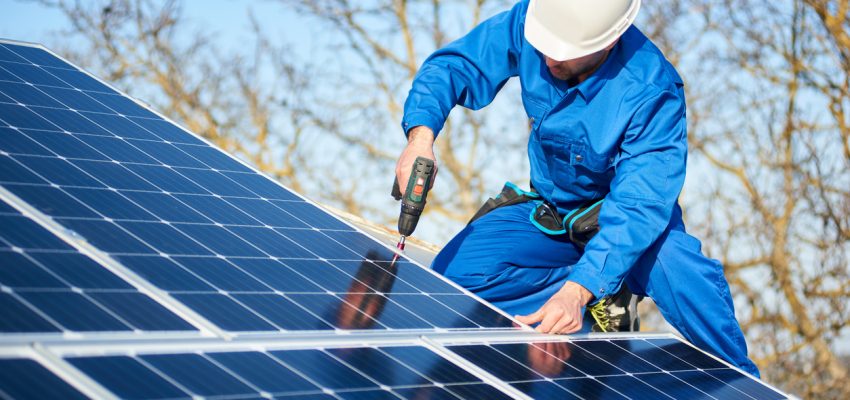If you’re interested in solar power, there are a few issues you should consider before you install solar panels. The location of your home is one of those issues.
But how does the Sun’s location affect solar panels? Keep reading to find out!
Angle of Incidence
The angle of incidence is a key factor that affects how well and how well solar panels work. When it comes to using the Sun’s energy to make electricity, the angle at which sunlight hits the surface of solar panels directly affects their ability to do so. Solar panel systems can get the most energy out of the sun by understanding and optimizing the angle of incidence.
Solar panels absorb sunlight best when it hits them straight on. This is called the optimal angle of incidence.
Usually around noon, when the Sun is directly overhead, the angle of incidence is close to 90 degrees. Solar panels can soak up the most sunlight at this angle and turn it into electricity.
As the Sun moves around during the day, so does the solar panel angle. When the Sun is lower on the horizon, like in the early morning or late afternoon, the angle of incidence goes up. This makes the sunlight hit the panels at a shallower angle.
This shallow angle makes it harder to get solar panel energy from the sun because some light bounces off the panels instead of being absorbed. So, during these times of the day, solar panels make less electricity.
Intensity of Sunlight
The amount of sunlight is one of the most important factors that affect how well and how much solar panels work. To get the most energy out of solar panel systems, you need to know where the Sun is and how its position affects the sunlight’s brightness.
Near the equator, the angle of the Sun is usually higher throughout the year. Because of this, the sun is generally stronger in these places than in places farther from the equator. Countries close to the equator, like those in the tropics, get consistently strong sunlight, making solar panels produce more energy.
Conversely, in regions located at higher latitudes, such as those closer to the poles, the Sun’s angle is lower, resulting in lower sunlight intensity. These areas experience reduced energy output from solar panels due to the lower amount of solar energy reaching the Earth’s surface.
Duration of Sunlight
The amount of time solar panels can use sunlight to make electricity is called the “sunlight duration.” It depends on many things, like the latitude of a place, the time of year, and where the Sun is in the sky.
Near the equator, daylight hours are usually more consistent and last longer throughout the year. This is because these areas are closer to the path of the Sun and have less change in daylight hours from season to season. Because of this, solar panels near the equator get a relatively steady and large amount of sunlight, which means they can make more energy.
On the other hand, regions located farther from the equator, such as those closer to the poles, experience significant variations in daylight hours throughout the year. During summer near the poles, the Sun may remain above the horizon for extended periods, resulting in longer daylight hours. In contrast, these regions may experience shorter daylight hours or periods of continuous darkness during winter.
Seasonal Variations
Seasonal variations significantly affect solar panels’ performance and energy production. During the summer, the Sun is higher in the sky, resulting in a more direct path for sunlight to reach the Earth’s surface.
Solar panels receive a higher intensity of sunlight during this time, as the sunlight travels through a shorter path in the atmosphere. The higher angle of the Sun also leads to a more favorable angle of incidence for solar panels, maximizing their energy absorption. As a result, solar panels tend to generate more electricity during the summer months.
In contrast, the Sun’s angle is lower during winter, resulting in a longer path for sunlight to travel through the Earth’s atmosphere. The increased atmospheric distance leads to higher absorption and scattering of sunlight, resulting in lower intensity.
Solar panels receive less direct sunlight and a less optimal angle of incidence during winter months, reducing their energy production compared to the summer season. Companies like Blue Raven Solar understand the importance of accounting for these seasonal variations in their solar panel installations to maximize energy generation throughout the year.
Shading
Shade can make a big difference in how well and how well solar panels work. To get the most energy out of solar panel systems, designers and installers must carefully consider where the sun is and how it might shade panels.
When buildings, trees, or other structures block the sun from reaching solar panels, this is called shading. Even a tiny amount of shade on a solar panel can significantly affect its output because it reduces the amount of sunlight used to make energy.
To avoid too much shade, you must know where the Sun goes throughout the day and year. This information helps determine where and how to put solar panels so they get the most sunlight and cause the slightest shade.
Solar Panels Shine Brighter With the Sun’s Location on Their Side
The increasing demand for clean energy has made solar panels an essential infrastructure component. The sun’s location relative to the panels affects the power generated by the panels.
Location is a critical consideration in getting the most out of solar power. Installing solar panels in sunny, well-positioned locations will help maximize the benefits of solar energy, so consider your local climate and contact an expert in solar power to put you on the path to clean energy success.
We hope you enjoyed reading this article. Check out our blog for more informative resources if you found it helpful.




